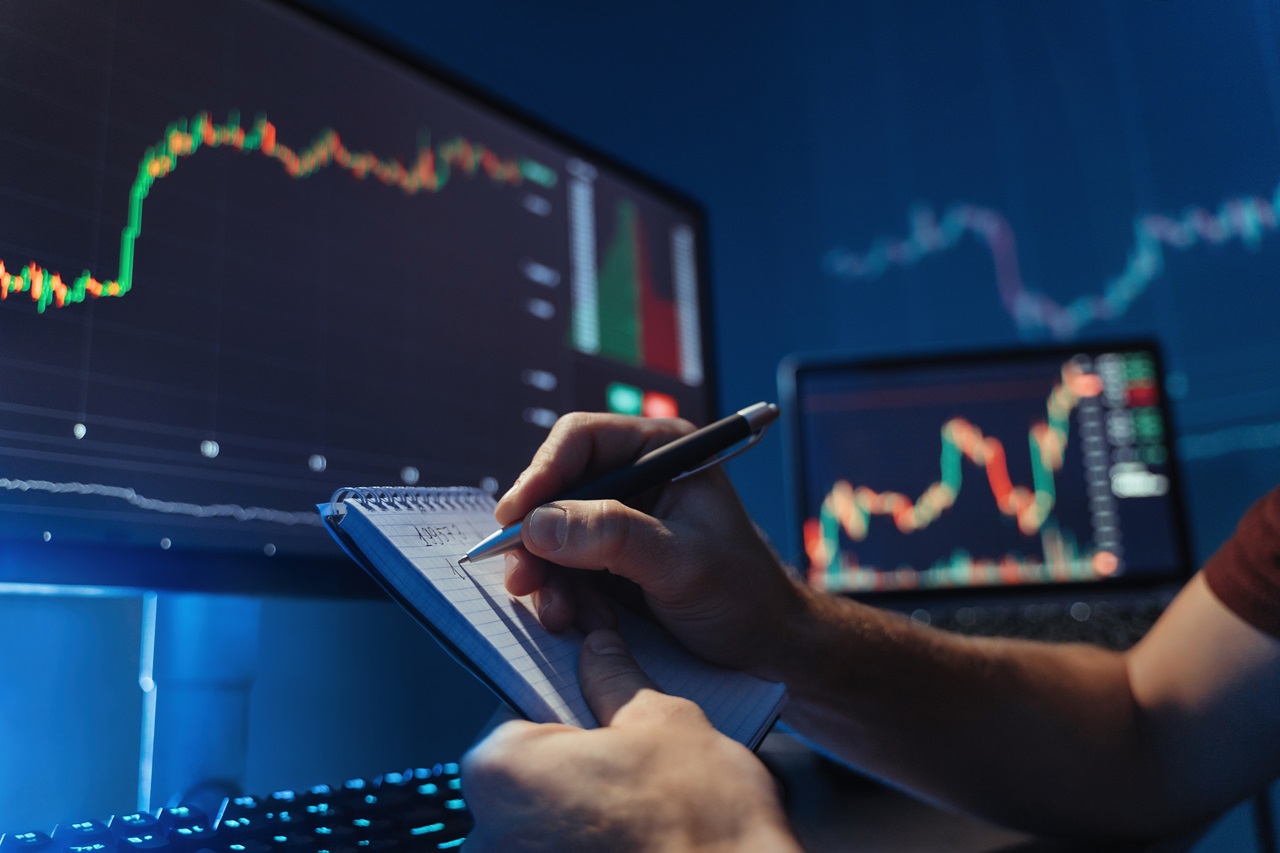
If you've explored the world of cryptocurrencies, you've likely encountered terms such as 'resistance,' 'support,' and 'moving averages.' These terms are the heart of crypto technical analysis, a critical tool for traders and investors alike. Whether you're a novice or a seasoned trader, understanding crypto technical analysis can unlock valuable insights into market trends and price movements. This practice uses historical data to predict potential price patterns, helping you make more informed decisions. So, allow me to demystify this complex subject and take you on a journey into the fascinating world of crypto technical analysis.
Technical Analysis: A Comprehensive Overview
Technical analysis is a trading discipline that uses statistical trends gathered from trading activity, such as price movement and volume, to predict future financial outcomes. Rather than focusing on a digital asset's intrinsic value, crypto technical analysis utilizes historical trading data to gauge potential future price moves. This mainly involves identifying patterns and trends on price charts, which traders use to make a wide array of short-term and longer-term trading decisions.
Now, you might be wondering, "How does this work exactly?"
Unraveling the Inner Workings of Technical Analysis
At its core, the premise of technical analysis lies in a few foundational concepts:
- Price Discounts everything: At any given moment, an asset's price reflects everything that has or could affect the company, including fundamental and macroeconomic factors.
- Trends: Prices move in trends, with three dominant trends being upward (bullish), downward (bearish), or sideways (neutral). Understanding these movements helps anticipate future price action.
- History Tends to Repeat Itself: Since market psychology influences pricing, previous price patterns can reoccur, which traders use to predict price movements.
The Pillars of Crypto Technical Analysis
Crypto technical analysis primarily revolves around the aforementioned principles, but there are more specific elements. These include:
- Charts: The essential tools of technical analysts, which display price and volume data in various formats (like line, bar, or candlestick) over diverse time frames.
- Pattern analysis: A key skill in technical analysis is spotting patterns on charts (such as 'Head and Shoulders' or 'Double Top') that indicate likely price behavior.
- Trading volume: A crucial factor that indicates how many units of a cryptocurrency were bought and sold, which often signals the strength of a price trend.
- Technical indicators: Calculations used to forecast price changes, such as Moving Averages or Relative Strength Index (RSI).
Despite dealing with mathematical formulas and technical terms, don't worry – with time and practice, you'll become familiar with applying these to your trading strategies. Understanding this framework is crucial for anyone looking to explore the exciting world of crypto trading through technical analysis.
Key Components of Crypto Technical Analysis
When you're engaged in crypto technical analysis, there are several key components you'll need to keep in mind. Each plays an essential role in helping you accurately understand, predict, and strategize your forthcoming crypto trades. Let's take a deeper look at the vital pieces of the crypto technical analysis puzzle.
Price Action
At the heart of crypto technical analysis is price action. This refers to the movement of a cryptocurrency’s price over time, which is visually represented on a chart. By studying price actions, you can begin to identify trends and patterns that can guide your future investments.
Cryptocurrency Charts
Cryptocurrency charts provide a graphical representation of price movements over a specified period. Different types of charts - such as line charts, bar charts, and candlestick charts - offer unique perspectives on price action and are vital tools in a crypto analyst's toolbox.
Volume
Another critical component is volume, which represents the total number of coins traded during a given period. Volume provides insights into the strength or weakness of a price move and can indicate potential turning points in market action.
Market Trends
Identifying and understanding market trends is crucial in crypto technical analysis. Trends, whether they're upward, downward, or sideways, can provide significant clues about potential future price movements.
Technical Indicators
Finally, technical indicators are mathematical calculations based on a cryptocurrency’s price and volume. Various indicators, like moving averages or relative strength index, can aid in predicting future price changes and provide buy or sell signals.
As you can see, crypto technical analysis is a multi-faceted process. By understanding and utilizing these key components, you're better positioned to make informed decisions in the often unpredictable world of cryptocurrency trading.
Chart Patterns and Trend Analysis in Cryptocurrency
Now that we’ve laid the groundwork on the fundamentals of crypto technical analysis, one of the most significant aspects of crypto trading - chart patterns and trend analysis - deserves our attention. Recognizing chart patterns and analyzing trends is an integral part of predicting the future movements of a cryptocurrency's price. So, let's delve into this crucial realm.
Unveiling Cryptocurrency Chart Patterns
The formation of chart patterns in the market can often suggest the potential for a continued or impending price movement, which in turn can signal a trading opportunity. Some key patterns to keep an eye out for are:
- Head and Shoulders: This pattern indicates a reverse trend – a sign that the cryptocurrency's price could soon change direction.
- Double Top: It signifies a bearish reversal pattern, hinting at potential downward pressure on the price.
- Triangles: Depending on the type (ascending, descending or symmetrical), triangle patterns can suggest bullish or bearish price movement.
The Art of Trend Analysis
Meanwhile, trend analysis is the practice of studying the movement of cryptocurrency prices to identify a direction (upward, downward, or sideways). There are also certain trends that traders should be aware of:
- Bullish: An upward trend, indicating increasing prices.
- Bearish: A downward trend showing decreasing prices.
- Consolidating: When the price appears to be moving sideways, indicating a pause in the trend.
Understanding and recognizing these chart patterns and trends could potentially help you anticipate the next move in the crypto market before others can. However, while they can provide valuable insights, they shouldn’t be relied upon solely; always corroborate your observations with other aspects of your technical analysis.
Importance of Volume and Volatility in Crypto Technical Analysis
Volume and volatility are both vital components in the realm of crypto technical analysis. They often serve as significant clues to the underlying shifts in market sentiment and can be used to predict potential price movements. But, what exactly is volume and volatility in the cryptocurrency context? Let's delve a bit deeper.
Understanding Volume in Cryptocurrency
Volume, in the simplest terms, represents the total number of coins that are traded within a specific timeframe. It’s a reflection of market activity and interest in a particular coin. Higher volume often suggests greater liquidity and stability, which in turn provides a speculative trader with much-needed assurance about both buying and selling opportunities.
A sudden spike in volume may indicate drastic shifts in market sentiment. For instance, if there is a substantial increase in trading volume in tandem with a price hike, it often suggests a bullish trend. Conversely, if the trading volume significantly dips while the price decreases, it can be viewed as an indication of a bearish trend. Thus, understanding volume is a critical component of predicting market movement.
The Role of Volatility in Cryptocurrency Technical Analysis
Volatility, by definition, refers to the rate at which the price of a cryptocurrency increases or decreases for a set of returns. Cryptocurrencies, by their inherent nature, are often subject to higher volatility compared to traditional fiat currencies. This means the price of a cryptocurrency can change rapidly in a very short time, making it possible for investors to experience significant gains or losses.
An increased level of volatility creates a more vibrant and dynamic trading environment with higher risk and reward. However, because of this unpredictability, crypto investing often creates a scenario comparable to the Wild West - where fortune and risk are inextricably intertwined. Thus, the understanding and monitoring of volatility become essential in technical analysis.
In conclusion, volume and volatility are essential tools in the toolkit of a crypto technical analyst. Understanding how to interpret these elements provides insightful clues into market sentiment and potential price movements, which can be used to enhance trading decisions.
Technical Indicators and Their Significance in Crypto Analysis
In the world of crypto technical analysis, technical indicators play a pivotal role. These are statistical tools that traders use to assess and interpret market trends, guiding them towards informed trading decisions. Crypto analysts leverage technical indicators to gauge both market momentum and trends, with the ultimate aim of predicting future price movements.
Understanding the Different Types of Technical Indicators
There are, broadly speaking, four primary types of technical indicators: trend, momentum, volatility, and volume indicators. Each serves its own unique function within the scope of technical analysis.
- Trend Indicators: As the name suggests, trend indicators (or trend-following indicators) are geared towards identifying the existence and direction of a trend. This can help traders to determine the best time to enter or leave a trade. A well-known example of a trend indicator is the Moving Average (MA).
- Momentum Indicators: Momentum indicators assist traders in identifying the speed at which the price of a cryptocurrency is changing. By evaluating the strength of a trend, these indicators can provide insights into potential reversals or rallies. The Relative Strength Index (RSI) is a popular momentum indicator.
- Volatility Indicators: Since volatility is a primary characteristic of the cryptocurrency market, volatility indicators are especially useful in crypto technical analysis. They help to measure the rate at which the price of an asset increases or decreases for a set of returns. Bollinger Bands® are a commonly used volatility indicator.
- Volume Indicators: These tools allow traders to see the volume of crypto coins being traded during a certain period. On-Balance Volume (OBV) and the Volume Rate of Change (ROC) are standard volume indicators.
Making Sense of Technical Indicators
Although technical indicators can be extremely effective tools, it’s worth noting that they are not infallible. Like any tool, their efficacy depends on the skill and experience of the individual wielding them. In other words, the accuracy of technical indicators hinges on the trader's ability to interpret them correctly.
Also, different technical indicators can sometimes give conflicting information. Therefore, a good strategy for traders is to use multiple indicators to confirm trends and signals - a technique known as confluence, which can lead to more reliable trading signals and improve the chances of trading success.
Technical Indicators: A Caveat
A common misstep traders make is assuming that technical indicators provide foolproof trading signals. It's critical to remember that these are merely tools to aid decision-making, not crystal balls able to predict market outcomes with 100% accuracy. Successful trading depends on a robust analytical approach, of which technical indicators are just one part.
Remember, while technical indicators are an essential part of crypto technical analysis, there's no such thing as a 'sure thing' in trading. The crypto markets are subject to myriad influences, including economic indicators, technological advancements, regulatory developments, macroeconomic trends, and much more.
Common Pitfalls in Crypto Technical Analysis
It's undeniable that crypto technical analysis is a useful tool when venturing into the cryptocurrency market. However, like all tools, its value lies in the user's proper understanding and application. One must be aware of the common pitfalls in order to utilize it effectively. Let's delve into these potential falls and how to avoid them.
Overconfidence in Technical Analysis Tools
An over-reliance on chart patterns and indicators can be a major pitfall. It's essential to understand that technical analysis is not a crystal ball that can predict future market behaviour with absolute accuracy. While it provides insightful data, it's still based on historical price movements, which are not always perfect indicators of future performance.
Disregard for Market News and Events
It's easy to get so engrossed in charts and patterns that one forgets other critical aspects influencing the market. Factors like news events, government decisions, technological advances, and market sentiments play a significant role in cryptocurrency trading, and while these factors might not show up on a chart, they can drastically overrule the patterns and predictions made by technical analysis.
Incorrect Use of Technical Indicators
Misinterpretation or incorrect application of technical indicators can easily lead to disastrously wrong decisions. For instance, relying on a single indicator could potentially provide a limited and potentially misleading view of the market. It is critical to use multiple indicators and consider the bigger picture.
Lack of a Structured Trading Plan
One of the biggest pitfalls beginners face in technical analysis is entering the market without a structured plan. Trading cryptocurrencies without a strategy is akin to navigating choppy seas without a map – it increases the chances of taking impulsive decisions and falling prey to market volatility. Defining clear entry and exit points, understanding risk-management, and setting realistic profit targets are essential to the success of a trader.
To conclude, it's important to remember that while technical analysis offers a systematic approach to trading, it should be used carefully, understanding its limitations and complementing it with sound decision-making and risk management strategy.
Future Trends: The Role of Technical Analysis in Cryptocurrency's Future
No crystal ball can accurately predict the future of cryptocurrency, but proficient use of technical analysis can give us some insightful hints. This tool has made strides in unlocking future potentials of different cryptocurrencies even amidst unforeseen market fluctuations.
Introducing Forecasting in Crypto Analysis
Forecasting in crypto technical analysis is akin to looking into a telescope, attempting to discern the trajectory of specific cryptocurrencies. It's about understanding potential price movements and determining likely market trends. The goal here is to pinpoint high-probability opportunities based on past and present market behavior.
The Power of Algorithms in Future Crypto Analysis
Algorithms hold immense power in future suitability of crypto technical analysis. They bring a new edge to the trading scene, allowing for automatic analysis based on set criteria and intricate calculations. Advanced algorithms take into account numerous factors, such as price, volume, market trends, and technical indicators to provide precise predictions. These can facilitate faster, more decisive trading actions.
Artificial Intelligence: A Possible Game-Changer
The landscape of crypto technical analysis may face a significant shift as artificial intelligence (AI) makes strides into the scene. AI's ability to learn, adapt, and respond independently can contribute to a more fluid and accurate decision-making process. Coupled with machine learning algorithms, AI can significantly enhance predictive accuracy and offer unique insights into future market movements.
Long story short, while the science behind crypto technical analysis is ever-evolving, the rationale for its use remains inarguable. It has, and will continue to be an indispensable tool in the hands of those adept and wise enough to use it correctly.
Conclusion: Harnessing Technical Analysis for Cryptocurrency Trading
As we wrap up our detailed exploration into the realm of crypto technical analysis, it becomes clear how this field can greatly enhance your cryptocurrency trading strategies. By meticulously understanding and employing the principles, components, patterns, and indicators of technical analysis, you can confidently navigate the often turbulent crypto markets.
Keep in mind, however, that technical analysis isn’t a crystal ball into the future. Instead, it’s a strategic tool which allows you to recognize potential trading patterns, interpret market sentiment, and make informed decisions.
But how can we effectively harness technical analysis for trading?
Integration of Tools and Techniques
One significant way is integration. The utilization of various analytical tools and techniques in tandem can offer more comprehensive insights. The simultaneous use of price action, volume, indicators, and chart patterns could provide a more holistic view of market status.
Continuous Learning
Never stop learning. With the continuous evolution of the crypto market, staying up-to-date with the latest analytical tools, trends, and technical indicators is crucial. Remember, the market never sleeps, and neither should your knowledge discovery process.
Blend of Fundamental and Technical Analysis
A balanced blend of fundamental and technical analysis often yields the best results. While technical analysis helps to identify the direction and momentum of the price, fundamental analysis presents the broader picture of the market, allowing for more informed trading decisions.
Patience and Discipline
Lastly, patience and discipline are key. They ensure that you stick to your trading plan, understand the risks involved, and avoid emotional trading decisions. Remember, the crypto market is highly volatile. Risk management should always be a priority, and technical analysis can play a pivotal role in managing those risks.
In conclusion, the power of crypto technical analysis is immense but it should be wielded with care. Stay informed, keep learning, and most importantly, trade wisely.



